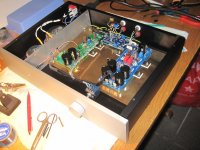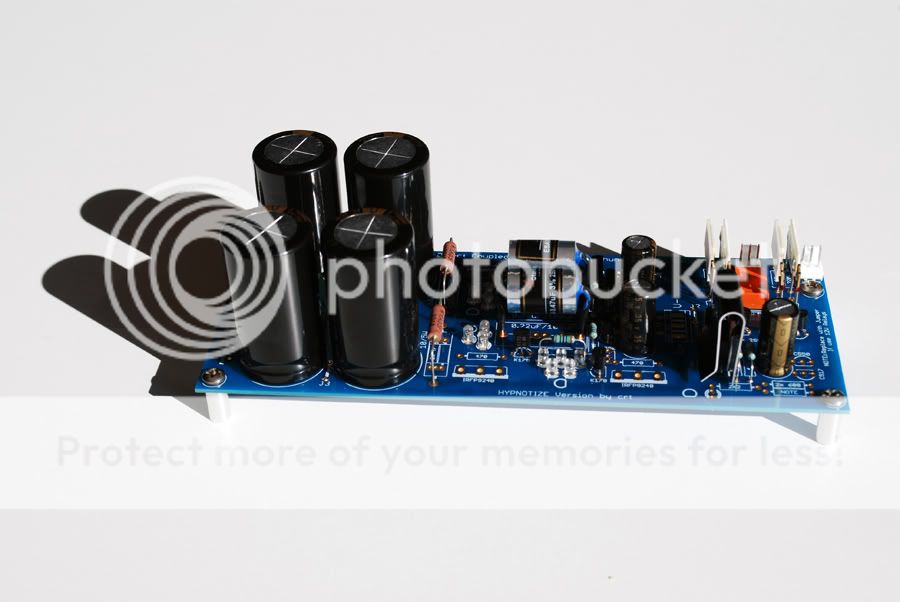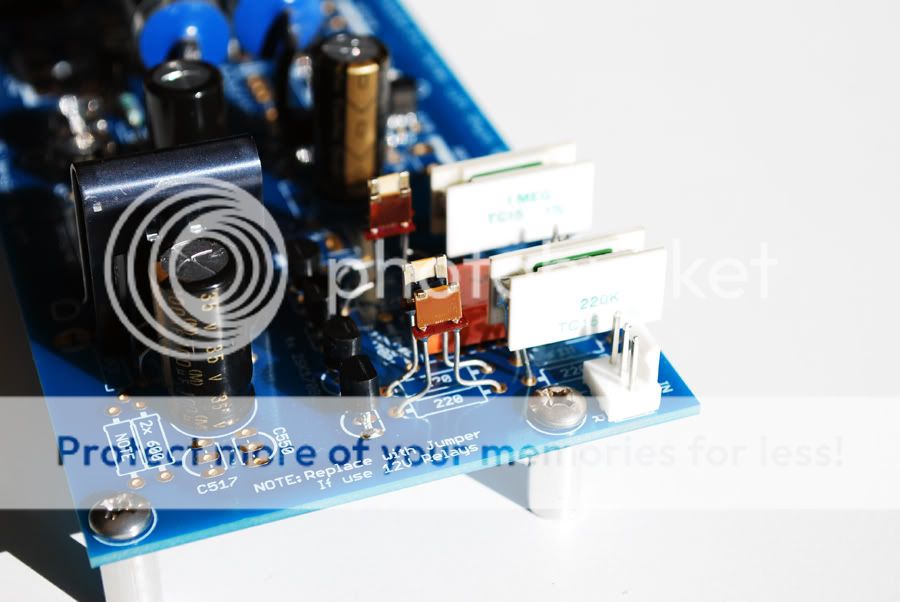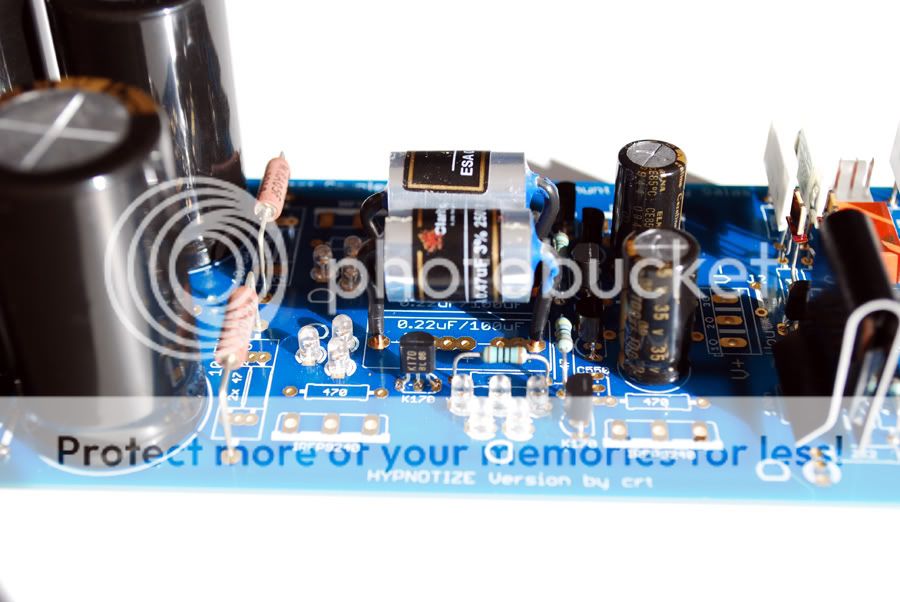Hello Salas,
Thanks for your explanation, learned something again. Downloaded a 1kHz mp3 0 dB. It shows 1,98V. Maybe too low for the combi then. The values in the A-18 scheme I don't have at hand anymore, it's old.... Guess I will see if the dcb1/f5 combi plays what the verdict will be. I will let you know when it's finished, but already thanks for all your effort.
Joffrey
Thanks for your explanation, learned something again. Downloaded a 1kHz mp3 0 dB. It shows 1,98V. Maybe too low for the combi then. The values in the A-18 scheme I don't have at hand anymore, it's old.... Guess I will see if the dcb1/f5 combi plays what the verdict will be. I will let you know when it's finished, but already thanks for all your effort.
Joffrey
Finally Working - Yeah!
My DCB1 is working now with switch, fuses, and everything. My wiring mistakes on the inputs and outputs (the ground is not connected - now I soldered directly to the PCB) cost me a pair of tweeters and the shipping charge for Emotiva XPA-2 - not too bad considering what I've learned from the mistake.
The Emotiva is back. The repair report says it was over driven and the resistors on one of the output filter were burned. Right now I hook up with the Class D amp to my Scan Revelators.
Thanks Salas, Tea Bag, and everyone helped.
My DCB1 is working now with switch, fuses, and everything. My wiring mistakes on the inputs and outputs (the ground is not connected - now I soldered directly to the PCB) cost me a pair of tweeters and the shipping charge for Emotiva XPA-2 - not too bad considering what I've learned from the mistake.
The Emotiva is back. The repair report says it was over driven and the resistors on one of the output filter were burned. Right now I hook up with the Class D amp to my Scan Revelators.
Thanks Salas, Tea Bag, and everyone helped.
Grounding DCB1
Salas,
Another observation I want to share is that the DCB1 is quite even in a cardboard box. My original B1 will create big hum without metal enclosure in the same environment.
I did not "Ground" the DCB1 yet. Should I connect the Ground pin from the IEC to somewhere on the PCB? I want to build a MDF box with wood veneer for it but want to know what could go wrong first and what's the right way to do a chassis ground on this design.
I currently use two 25K mono pots. I will add the LightSpeed volume control this weekend.
Salas,
Another observation I want to share is that the DCB1 is quite even in a cardboard box. My original B1 will create big hum without metal enclosure in the same environment.
I did not "Ground" the DCB1 yet. Should I connect the Ground pin from the IEC to somewhere on the PCB? I want to build a MDF box with wood veneer for it but want to know what could go wrong first and what's the right way to do a chassis ground on this design.
I currently use two 25K mono pots. I will add the LightSpeed volume control this weekend.
Good for you. Lesson learned the smoke way, is be careful from now on, don't haste when building.
You will add a metal floor at least to your wooden box and there you will tie your mains ground with a short 1.5mm2 cable next to the IEC receptacle. You will insulate all nude mains prongs and cable ends also. IF there will be hum, you will run a short cable from where the board reads G (at the end of the regs before the audio portion) to the metal panel. You will also ground the pots bodies same way if they are encased in metal. You will place the transformer to the farthest diagonal distance in respect to the RCAs. Stay away from the IEC and the board GND for now, don't experiment.
The safest and most advisable thing to do is to tie the IEC earth yellow-green cable to the chassis with a bolt. Then tie the main ground from the board to the same bolt.Salas,
Another observation I want to share is that the DCB1 is quite even in a cardboard box. My original B1 will create big hum without metal enclosure in the same environment.
I did not "Ground" the DCB1 yet. Should I connect the Ground pin from the IEC to somewhere on the PCB? I want to build a MDF box with wood veneer for it but want to know what could go wrong first and what's the right way to do a chassis ground on this design.
I currently use two 25K mono pots. I will add the LightSpeed volume control this weekend.
If using a wooden box, just join the IEC earth to the board ground.
Is there a better advice safetywise?
As usual my (arguable) point of view on these matters: if you like to keep your audio circuits clean please do not connect the boards GND directly to the IEC receptacle. Better use a heavy wattage resistor 10 Ohm or a Thermistor like Nelson Pass uses in some of his designs.There are various threads on this subject here. It has no use polluting your audio by connecting audio-GND straight to a non clean PE. It will also give more chances to have ground loops. Safety-wise there are some other angles. One of them is that PE is more or less a very good "earth" (which it is not in practice). I have had numerous occasions where PE connection caused more problems than it solved in terms of pollution. I very well realize I am on thin ice here when safety regulations are concerned as not every reader is capable of deciding which solution is according these regulations so "just connect GND to PE" is often the easiest solution when safety is concerned. Again, that is not the case for optimal results of your self built audio gear in many cases (only if it is mechanically and electrically well designed/well built of course
Example: I would not doubt a second to connect tube gears audio GND directly to PE !!!!
Another example: when a plastic case is used with a metal subchassis I would connect the subchassis directly to PE but I would not connect GND to PE at all as risks of touching live metal covers is non existent.
PE is for safety but it is also the sewer for getting rid of EMC/RF from switching power supplies, mains pollution, overvoltage protection circuits etc, etc. Stuff you don't want to creep in your gear via PE -> GND...
Example: I would not doubt a second to connect tube gears audio GND directly to PE !!!!
Another example: when a plastic case is used with a metal subchassis I would connect the subchassis directly to PE but I would not connect GND to PE at all as risks of touching live metal covers is non existent.
PE is for safety but it is also the sewer for getting rid of EMC/RF from switching power supplies, mains pollution, overvoltage protection circuits etc, etc. Stuff you don't want to creep in your gear via PE -> GND...
Last edited:
LightSpeed Volume Control
So I cheated on my schedule. I installed the LightSpeed tonight. It's working on my Lepai Class T $20 amplifier. No hum or anything - very quite. I'll let it run for a while and move them to the "real" speakers.
This time I checked everything before putting everything together. My Emotiva still in the box. It's way too heavy.
DCB1 has more dynamics and details than the B1. Now with LightSpeed - don't know what I should expect. Perhaps I should build another one with Hot Rod?
So I cheated on my schedule. I installed the LightSpeed tonight. It's working on my Lepai Class T $20 amplifier. No hum or anything - very quite. I'll let it run for a while and move them to the "real" speakers.
This time I checked everything before putting everything together. My Emotiva still in the box. It's way too heavy.
DCB1 has more dynamics and details than the B1. Now with LightSpeed - don't know what I should expect. Perhaps I should build another one with Hot Rod?
I agree with you regarding the DCB1 against the B1; the Salas unit is absolutely brilliant. I'm interested to hear what you think of the Optivol and DCB1 together having built both but not yet got around to trying them together myself.
Not sure if my subjective listening experience will help you but if I care that much to vent, it must be really good.
LightSpeed + DCB1 is working and it is dead silence on my system. As I mentioned before, B1 won't survive without a metal enclosure in the same environment. LightSpeed + DCB1 are in an open cardboard box.
With B1+CDA254, it is good. It sounds way better than my old HK 635. But during extended listening, there is a slightly "bright" tone on some content, which generates a tiny bit litsening fatigue. My speakers are ruler flat using Scan Revelators. In comparison, the B1+Emotiva XPA-2 doesn't have that "brightness", the sound stage is more extended, more dynamics, and the etc. In some content, B1+CDA254 could be a bit "dull" or not engaging.
For the "dullness", this is compared to my friend's $$$$$$$ Ayre system using the same speakers. There is an argument saying the difference I'm hearing between B1+CDA254 and B1+Emotiva is because impedance mismatch. I know too little on this area to comment (B1 - 1K, CDA254 7K, Emotiva 35K). Anyone want to chime in?
With DCB1+CDA254 - more dynamics. It removes the "dullness" feeling. I did not do an extensive listening on this because I put on the LightSpeed two days after. With LightSpeed, the immediate difference is in the mid-high frequency, say 1K-3K, where most harmonics and timbre reside. It is beautiful. Just like designing speakers, I usually listen to one channel on axis first, take measurements and move on to stereo. I haven't done the stereo on my Scans yet. By experience, what I'm currently hearing will lead to a big and massive sound stage when putting in stereo.
My Emotiva has came back. It's so heavy so I won't be hooking it up until I'm happy with all other placement (moving XPA-2 is a real pain). But the current combo is very good (LightSpeed + DCB1 + CDA254). I no longer feel I missed something from my friend's Ayre system. Actually, I was happy with B1+CDA254 and I spent majority of my time working on speakers. The upgrade was triggered after I hook my speakers to my friend's Ayre system - I didn't know the speakers can sound that good. But from ROI perspective, it is not that good to demand that much money (> $10K) from me.
Hope this helps. Now I want to build another Hot Rod DCB1.
DCB1 evaluation
Salas, the DCB1 is playing now for a few days and I must say it sounds super. Sounstage is suddenly much bigger, wider and deeper, there is more body, piano is clear and has weight, bass is thight and has punch. Voices are accurate without sharpness. It puts a big smile on my face with now and then disbelieve of things I really didn't hear before. The F5 is today ready too and already makes a good couple, needs a bit more burn in. Thank you and Tea Bag, dvb-projekt, spencer and others.
Salas, the DCB1 is playing now for a few days and I must say it sounds super. Sounstage is suddenly much bigger, wider and deeper, there is more body, piano is clear and has weight, bass is thight and has punch. Voices are accurate without sharpness. It puts a big smile on my face with now and then disbelieve of things I really didn't hear before. The F5 is today ready too and already makes a good couple, needs a bit more burn in. Thank you and Tea Bag, dvb-projekt, spencer and others.
Attachments
please help with the DC coupled B1 - Hypnotize version
Hi everyone,
I build one of the hypnotize dc coupled B1. and made some mistake with the transformer and lead to the burn the right side of the diode, and i found that i missplace the second irfp240 and irfp9240.
i change the diode and test
result is :
one side of led is working (the side on the irfp9240)..all led is lit but very low intensity and on the side of irfp240 the 5 led doesn't lit.
if i pull out the irfp240 the 5 led on the side of irfp9240 lit normally.
i didn't measure the voltage and current arround componen,
is there anybody can help me with this problem
many thanks before
regards
denis
Hi everyone,
I build one of the hypnotize dc coupled B1. and made some mistake with the transformer and lead to the burn the right side of the diode, and i found that i missplace the second irfp240 and irfp9240.
i change the diode and test
result is :
one side of led is working (the side on the irfp9240)..all led is lit but very low intensity and on the side of irfp240 the 5 led doesn't lit.
if i pull out the irfp240 the 5 led on the side of irfp9240 lit normally.
i didn't measure the voltage and current arround componen,
is there anybody can help me with this problem
many thanks before
regards
denis
Hot Rodding a DCB1 increases the current going to the board. The stock current is around 60mA(?) w/ 34ohms (those parallel 68Rs on each side). But the more current you feed the mosfets, the better the sound quality as a general rule. Salas indicates this occurs in tiers, ~200mA being the next tier, 600mA after that, and then around 2A(!). But there's a catch: Heat. The more current, the hotter those mosfets get. Stock values you can forego heatsinks, but beyond that you'll need them. I'm pushing 600mA on my DCB1, using the entire 12x12 enclosure of my integrated amp as a heatsink with the mosfets bolted to the chassis AND a fan installed.
Is it worth increasing the current. Yes. Definitely the 200mA tier at least. Soundstage, three-dimensionality increases.
How do you increase the current? Resistors. The resistors by the PS caps. The BOM lists parallel 68R (=34ohms) as basic value (though the board shows 47R, which is fine as well), and 10ohm 5W for hot-rodding. You do not use 2 10R per side, just 1. This a guideline, you can increase or decrease values as you deem fit.
Could someone please tell me what value resistors to use for:
200ma
600ma
2A
I have some more questions as I put together my BOM:
I am thinking that running 2A may not be worth the energy cost or reduced parts life. If I stay at 600mA, will the 50VA Antek transformer do (http://www.antekinc.com/pdf/AS-0515.pdf) or for the small incremental cost should I just get the 100VA version (http://www.antekinc.com/pdf/AS-1215.pdf)?
These are the best heatsinks I can find on Mouser: WA-T247-101E Ohmite Heatsinks
How much current do you think I can run with these?
I am also ordering some JFETS from Spencer. He matches them to .2mA, which I assume is as good as it gets, but I can also select the Idss. What is optimal?
I am thinking that running 2A may not be worth the energy cost or reduced parts life. If I stay at 600mA, will the 50VA Antek transformer do (http://www.antekinc.com/pdf/AS-0515.pdf) or for the small incremental cost should I just get the 100VA version (http://www.antekinc.com/pdf/AS-1215.pdf)?
These are the best heatsinks I can find on Mouser: WA-T247-101E Ohmite Heatsinks
How much current do you think I can run with these?
I am also ordering some JFETS from Spencer. He matches them to .2mA, which I assume is as good as it gets, but I can also select the Idss. What is optimal?
- Home
- Amplifiers
- Pass Labs
- Building a symmetrical PSU B1 buffer





